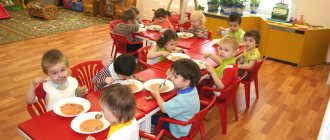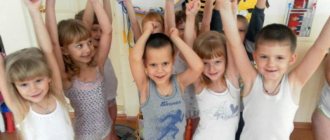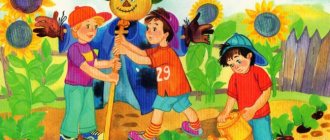Exercises for different groups
Gymnastics after sleep in the younger group
Daytime sleep is longest in the younger group of kindergarten. It can be difficult for kids to wake up in a good mood. If they were in a deep sleep, they may not immediately realize where they are. Children cry, are capricious, refuse to get up, wash, or get dressed. Therefore, during the exercises, the emphasis is on the emotional component of gymnastics: the correct selection of music, speech accompaniment, harmonization of the general atmosphere of the lesson. The images that the teacher will create during the exercises should be attractive.
Set of exercises “Sunshine”
A ray of sunshine woke up in the sky, A ray of sunshine reached out to the window.
There, outside the window, twenty children lie together in cozy beds. (Children stretch while lying in bed)
Hey, wake up, girls, boys!
You need to wear a dress and pants! Where are your pens? (Raise their hands and shake them in turn)
Where are your legs?
(Raise their legs, take turns doing swings)
Now we’ll play with you a little!
Come on, imagine that summer has come: The city has woken up, Rubbing their eyes with their fists).
And the sun rose.
(Raise their arms above their heads and stretch).
That is great!
So, let's ride into the distance along the path on a bicycle! (Doing the “Bicycle” exercise)
We drove and drove... - We arrived at the mill!
(Doing the “Mill” exercise)
Then we went. We drove, we drove... - We arrived at the river.
Let's help your feet, Let's touch some water! (They get up from the cribs, lowering their legs one by one to the floor)
Ay, the water is cold!
Here is one leg... (They jump on the right leg)
But here is another leg, what a nimble one!
(They jump on their left leg)
We stood in the water, Swimmed, (I make movements with my hands imitating swimming) We dived... Oh, good!
(They do squats with their arms extended forward)
They stood up from heel to toe and walked out onto the sand together.
(On tiptoes they walk out of the bedroom into the common room, where massage mats have already been prepared)
They walked on sand - They stepped on pebbles.
Oh, it's hot! (They walk in place on rubber mats for 2 minutes)
And now we have risen,
(Converge in the center of the hall)
We hold hands together.
(Form a circle)
Stretched,
(Stretched),
Smiled.
(Smile at each other).
Finally we woke up!
Gymnastics after sleep in the middle group
Gymnastics for middle group students should include a larger number of exercises. It is aimed not only at the emotional unity of children, but also at the comprehensive improvement of the child’s body. Elements of breathing exercises are required. It is advisable to combine gaming techniques with a set of exercises to prevent visual impairment and posture.
Possible reasons for failure and solutions
When a child is just getting used to the garden, the new environment and the lack of familiar home rituals may prevent him from falling asleep. There is no loved one nearby (mom, dad, grandmother, nanny), so it’s scary to fall asleep. For older children, other reasons are possible: for example, the child gets up late in the morning and comes to kindergarten later than other children. Or his sleep-wake rhythm has been disrupted after the weekend.
The period of adaptation in kindergarten. The first weeks in kindergarten, the child psychologically adapts to the new rhythm of life, to new people, rules and activities. At this time, even despite visible fatigue and the desire to sleep, he may not want to go to bed, because for the first time he remains for a long time outside his usual environment and without loved ones. He may also have difficulty connecting with other children. When he gets used to the new situation and makes sure that after sleep there are interesting activities or walks, and in the evening he will definitely return home, he will go to bed with pleasure.
The fear of separation from the mother in the first months of visiting kindergarten also increases the baby’s anxiety and prevents sleep. It is most difficult for children of the younger group to cope with separation - at this age it seems to them every time that their mother has left forever.
During the adaptation period, it is important for parents to spend more time with their child outside the kindergarten, play and communicate. Therefore, it is better not to leave the child for the whole day at first, but try to pick him up immediately after sleep and go for a walk together in order to gradually teach him to go to the garden with joy.
In conversations with your child, you can encourage him to sleep during the day in kindergarten. A feeling of confidence can be conveyed by the words: “I know you can handle it, you will succeed”, “I will definitely come for you in the evening”, “I won’t be there, but Natalya Romanovna will be next to you, she will help you sleep.”
To reduce the level of anxiety, you can give your child a toy in kindergarten that the child is used to falling asleep with at home, or give him another, but also favorite one, with which it is pleasant to sleep in an embrace. It may be possible to negotiate with the teacher so that she sits next to the baby several times and reads a “home” book, helping him fall asleep.
Noisy neighborhood. Perhaps an active neighbor is preventing the child from sleeping. Here again, the teacher can come to the rescue. It is she who observes the situation during quiet time and may know better than others the reason why the child does not sleep. She can also ask the most active and vigorous ones to behave more quietly. Or organize quiet leisure time for them in the next room - in kindergartens they are increasingly creating such mini-groups for awake children during quiet time, especially in older groups.
Rituals before bed. Home rituals that precede daytime sleep (rocking in your arms, the presence of your mother, your favorite song) are not always possible in a kindergarten setting. And without them, the child may simply not be able to sleep. Therefore, it is better to give up pre-nap rituals at home in advance and teach your child to fall asleep on his own. And it’s better to move family bedtime traditions, such as reading together, talking, quiet games, to the evening.
Waking up late in the morning. The reason for refusing daytime sleep can also be a late rise - in this case, the child simply does not have time to get tired by quiet time. The optimal wake time for children aged 3–6 years is approximately 6 hours. Daytime naps in kindergarten usually last from 13:00 to 15:00. If a child, for example, wakes up in the morning at 8:30, then at 13:00 (4.5 hours later) he simply does not want to sleep yet.
To find the optimal morning wake-up time, start waking your child up between 6:30 and 7:00. Once he starts taking regular afternoon naps again in daycare, you can gradually move his morning wake-up time back a little later.
Weekends, holidays and holidays. Even if the whole family gets up at 6:30 a.m. every weekday, on weekends the situation can change dramatically, and sleep patterns get lost again. If it is difficult to get up “as usual” with the whole family, you can use a trick and arrange “duty”: for example, dad monitors compliance this weekend, and mom the next. You need to remember to maintain a sleep schedule not only on weekends, but also on vacation, and even on sick leave.
Lack of self-care skills. In kindergarten you need to change into your pajamas yourself and then put them back on. If a child has not yet fully developed these skills, then he will begin to worry long before quiet time, and then there will be no talk of any sleep.
Home training will help you learn to change clothes faster in kindergarten. You can turn the process into a game: race to get dressed or come up with a little rhyme that will make the dressing process fun. It is better not to buy clothes with complex fasteners or small buttons in which the child will get entangled; the best solution is Velcro wherever possible, clothes with elastic bands and a wide collar.
Physical discomfort. Sometimes a child has difficulty falling asleep because he doesn't feel well, he ate too much at lunch, he's cold, or it's too hot in the bedroom. Some children refuse to sleep because they are afraid of falling asleep too deeply and waking up in a wet bed; Perhaps this has already happened to them in kindergarten, and they have encountered negative comments about it.
A role-playing game can help to find out the reasons for the reluctance to sleep in the garden - for example, situations related to sleep in kindergarten can be played out at home with dolls or animals. Let the toys become a group, someone will be a teacher, someone will be a nanny. Often, problems in relationships with other children or the teacher, as well as uncomfortable sleeping conditions, are revealed precisely during such play.
Elements of gymnastics after sleep
Gymnastics after sleep is like a multi-colored mosaic that can be reassembled every day, creating a new image from its main elements. Daytime gymnastics, as an option, may include:
- stretching;
- breathing exercises;
- swing your arms;
- stroking biologically active zones;
- jumping;
- squats;
- simple elements of yoga;
- finger gymnastics;
- gymnastics for the eyes;
- visual-acoustic exercises.
Despite the fact that gymnastics after sleep is usually short-lived, the teacher can combine individual elements and use the developments he likes in fragments.
Video example of morning exercises:
Types of gymnastics after sleep
In the methodological developments proposed by experts, the following types of gymnastics after sleep can be distinguished:
- exercises in bed with elements of self-massage;
- play gymnastics;
- gymnastics with exercise equipment and sports equipment;
- walking or jogging on massage mats/paths.
When preparing the exercise, you can use any exercise equipment that is available in the kindergarten
. As can be seen from the list, daytime gymnastics becomes a powerful set of health procedures, competently and concisely structured in time, and most importantly, interesting and enjoyable for the child.
All exercises are carried out in stages, with a gradual increase in load, and are of a playful nature. They are aimed at general strengthening of the body, prevention of disorders of posture, vision and flat feet. Psychologically, gymnastics classes unite children in a group and help them get out of the state of internal stiffness into which, as if in a capsule, the baby is immersed during sleep.
The teacher is free to choose specific exercises. He independently assesses the capabilities and needs of his students, observes which exercises are especially loved by children and, if desired, varies the tasks so as not to turn the magic of the five-minute sports session into a routine.







